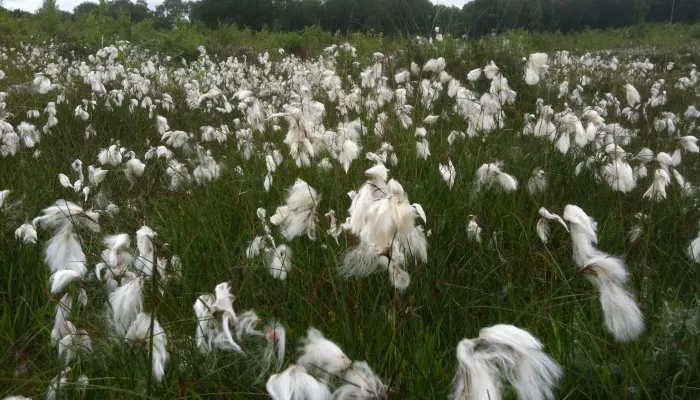Sweet vernal-grass
Flowering in spring, the cylindrical, densely packed flower spikes of Sweet vernal-grass are easily spotted in a meadow. It also tastes of sweet vanilla and was once a favourite 'chewing grass'.

Discover the plentiful species of grasses and rushes in Kent and how to identify them using our handy species guides.
Flowering in spring, the cylindrical, densely packed flower spikes of Sweet vernal-grass are easily spotted in a meadow. It also tastes of sweet vanilla and was once a favourite 'chewing grass'.
The stiff, spiky and upright leaves and brown flowers of hard rush are a familiar sight of wetlands, riversides, dune slacks and marshes across England and Wales.
The dense, spiky tufts of Marram grass are a familiar sight on our windswept coasts. In fact, its matted roots help to stabilise sand dunes, allowing them to grow up and become colonised by other species.
The dark green, straight and spiky stems of common club-rush or 'bulrush' are a familiar wetland sight. They are ideal for weaving and were traditionally used to make baskets, seats and mats.
As its name suggests, creeping bent runs along the ground before it bends and grows upright. It is a common grass of arable land, waste ground and grasslands.
Timothy is a grass of meadows, arable land, waste ground and roadside verges. It is also cultivated as fodder for livestock. Look for slender stems and long, cylindrical flower spikes in summer.
Perennial rye-grass is a tufted, vigorous grass of roadside verges, rough pastures and waste ground. It is commonly used in agriculture and for reseeding grasslands.
The extensive, golden-brown reedbeds that are formed by stands of Common reed are a familiar sight in our wetlands. They provide an important home for many species, including the rare Bittern.
Annual meadow-grass is a coarse, vigorous grass that can be found on waste ground, bare grassland and in lawns. In some situations, it can be considered a weed.
The fluffy, white heads of common cotton-grass dot our brown, boggy moors and heaths as if a giant bag of cotton wool balls has been thrown across the landscape!
Reed sweet-grass is a towering grass with large, loose flower heads that can be found on marshy ground near rivers, streams and ponds. It can become invasive, but does shelter various aquatic creatures.
Forming mats of straight, bright green stems, Common spike-rush does, indeed, look like lots of tightly clustered 'spikes' near the water's edge of our wetland habitats.
Cock's-foot is a common, tussocky grass of grasslands, woodland rides and cultivated ground - its fluffy, pinky-beige flower heads are quite distinctive.
A tall and robust species of sedge, the Great fen-sedge has long leaves with sawtooth edges. It forms dense stands in lowland fens and around lakes.
As its name suggests, quaking-grass can be seen quivering or 'quaking' in a breezy, summer wildflower meadow. Its purple-and-green, heart-shaped flower heads hang from delicate stems.
Sand sedge is an important feature of our coastal sand dunes, helping to stabilise the dunes, which allows them to grow up and become colonised by other species.
Growing in tufts, Crested dog's-tail is a stiff-looking grass, with a tightly packed, rectangular flower spike. Look for it in lowland meadows and grasslands.
As its name suggests, pendulous sedge has drooping form with long, nodding flower spikes that give it an attractive and soft look. It can be found in wet woodlands and along riversides.
Soft brome is a tall, annual grass of roadside verges, waste ground and meadows, and is a 'weed' of arable land. It has long, grey-green leaves and loosely clustered flower spikes.
A tussocky sedge, Greater pond sedge has stout, upright flower spikes, strap-like leaves and triangular stems. It prefers lowland wetland habitats on heavy soils.
Common couch is a tall, tuft-forming grass of roadside verges, waste ground and arable land. It is very tough and can shade out more delicate plants. Look for flat, blade-like leaves and thin flower spikes.
As its name suggests, the smooth stems of soft rush are thinner and more flexible than those of hard rush. It forms tufts in wetland habitats like wet woodlands, marshes, ditches and grasslands.
Field wood-rush is a short rush that forms tufts in grassy places, such as lawns, parks and downlands. A defining characteristic is its leaf-like leaves that are fringed with long, white hairs.
The distinctive spiky, or 'bearded', green flower heads of wall barley appear from June to July and are easy to spot in an urban environment as they push their way up through pavements and walls.
Wood melick is a slender, drooping grass that grows in dense patches in ancient woodlands and along shady banks. It has nodding flower heads, with brown, egg-shaped spikelets that contain the flowers.
The soft, downy look of Yorkshire-fog makes it an attractive plant, even if it is considered a weed of cultivated land! It is also attractive to the caterpillars of the Small Skipper butterfly as a foodplant.
A fluffy-looking grass of rough grassland, roadside verges and disturbed ground, False oat-grass is very familiar and often overlooked; in fact, it can help to stabilise dunes and shelter small mammals.
Great reedmace is familiar to many of us as the archetypal 'bulrush'. Look for its tall stems, sausage-like, brown flower heads and green, flat leaves at the water's edge in our wetland habitats.
Wavy hair-grass lives up to its name: its fine, hair-like leaves and delicate flower heads can be seen shaking in the breeze of a windswept moorland or heathland.
The true fox-sedge is a rare and threatened plant in the UK. It relies on lowland floodplain meadows and damp habitats, which are rapidly disappearing. Look for reddish-brown flowers in summer.